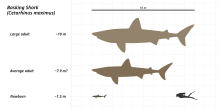| Basking shark Temporal range:
| |
|---|---|

| |

| |
| The size of basking sharks at various stages of growth and maturity with a human for scale | |
| Scientific classification | |
| Domain: | Eukaryota |
| Kingdom: | Animalia |
| Phylum: | Chordata |
| Class: | Chondrichthyes |
| Subclass: | Elasmobranchii |
| Order: | Lamniformes |
| Family: | Cetorhinidae |
| Genus: | Cetorhinus Blainville, 1816 |
| Species: | C. maximus
|
| Binomial name | |
| Cetorhinus maximus (Gunnerus, 1765)
| |

| |
| Range of the basking shark | |
| Synonyms | |
|
click to expand
| |
The basking shark (Cetorhinus maximus) is the second-largest living shark and fish,[4] after the whale shark. It is one of three plankton-eating shark species, along with the whale shark and megamouth shark. Typically, basking sharks reach 7.9 m (26 ft) in length. It is usually greyish-brown, with mottled skin, with the inside of the mouth being white in colour. The caudal fin has a strong lateral keel and a crescent shape. Other common names include bone shark, elephant shark, sailfish, and sunfish. In Orkney, it is called hoe-mother (contracted homer), meaning "the mother of the piked dogfish".[5]
The basking shark is a cosmopolitan migratory species found in all the world's temperate oceans. A slow-moving filter feeder, its common name derives from its habit of feeding at the surface, appearing to be basking in the warmer water there. It has anatomical adaptations for filter-feeding, such as a greatly enlarged mouth and highly developed gill rakers. Its snout is conical, and the gill slits extend around the top and bottom of its head. The gill rakers, dark and bristle-like, are used to catch plankton as water filters through the mouth and over the gills. The teeth are numerous and very small and often number 100 per row. The teeth have a single conical cusp, are curved backwards and are the same on both the upper and lower jaws. This species has the smallest weight-for-weight brain size of any shark, reflecting its relatively passive lifestyle.[6]
Basking sharks have been shown from satellite tracking to overwinter in both continental shelf (less than 200 m or 660 ft) and deeper waters.[7] They may be found in either small shoals or alone. Despite their large size and threatening appearance, basking sharks are not aggressive and are harmless to humans.
The basking shark has long been a commercially important fish as a source of food, shark fin, animal feed, and shark liver oil. Overexploitation has reduced its populations to the point where some have disappeared and others need protection.[8]
- ^ Sepkoski, Jack (2002). "A compendium of fossil marine animal genera (Chondrichthyes entry)". Bulletins of American Paleontology. 364: 560. Archived from the original on 10 May 2012. Retrieved 9 January 2008.
- ^ Rigby, C.L.; Barreto, R.; Carlson, J.; Fernando, D.; Fordham, S.; Francis, M.P.; Herman, K.; Jabado, R.W.; Liu, K.M.; Marshall, A.; Romanov, E.; Kyne, P.M. (2021) [amended version of 2019 assessment]. "Cetorhinus maximus". IUCN Red List of Threatened Species. 2021: e.T4292A194720078. doi:10.2305/IUCN.UK.2021-1.RLTS.T4292A194720078.en.
- ^ "Appendices | CITES". cites.org. Retrieved 14 January 2022.
- ^ "Basking Shark".
- ^ Yarrell, William. (1836). A History of British Fishes. Volume II. John Van Voorst, London. p. 397.
- ^ Kruska, DC (1988). "Brain of the basking shark (Cetorhinus maximus)". Brain Behav. Evol. 32 (6): 353–63. doi:10.1159/000116562. PMID 3228691.
- ^ Sims, DW; Southall, EJ; Richardson, AJ; Reid, PC; Metcalfe, JD (2003). "Seasonal movements and behaviour of basking sharks from archival tagging: no evidence of winter hibernation" (PDF). Marine Ecology Progress Series. 248: 187–196. Bibcode:2003MEPS..248..187S. doi:10.3354/meps248187.
- ^ Sims, DW (2008). "Sieving a living: A review of the biology, ecology and conservation status of the plankton-feeding basking shark Cetorhinus maximus". Advances in Marine Biology. 54: 171–220. doi:10.1016/S0065-2881(08)00003-5. ISBN 978-0-12-374351-0. PMID 18929065.
